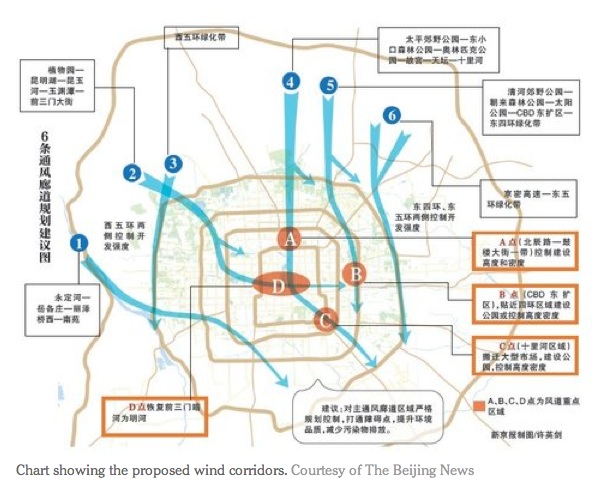Beijing tackles air pollution by shifting the muck around.

Beijing is planning a network of “ventilation corridors” to promote air flow and blow smpg away. Five main corridors will be 800 m wide and minor ones will be 80 m wide according to Wang Fei, deputy head of Beijing’s urban planning committee. Five main corridors are proposed. Peng Yingdeng, air pollution expert at Beijing Municipal Research Institute of Environmental Protection, advised the Beijing News that the plan was not for large-scale demolition or construction, but it was more an adjustment of current regulations to limit building heights and densities in specified areas. Beijing’s plan is to reduce air pollution levels by 40% by 2020.
source: http://www.bjnews.com.cn/news/2014/11/21/342614.html

ON 21 Feb, Xinhua (the Chinese news agency) advised “Beijing and its neighboring cities will start using uniform criteria when they issue pollution alerts by the end of March, the capital’s environmental protection bureau said on Sunday. Alerts will be categorized by Air Quality Index (AQI) readings. A red alert will be issued when the daily average AQI is forecast to rise above 500 for a day or longer. A red alert can also be issued when the daily average is forecast to climb above 200 for four straight days or longer, or when the daily average exceeds 300 for two days or longer. Beijing, Tianjin and Hebei Province employ different criteria for issuing pollution alerts. For instance, in Beijing, a red alert is issued when AQI exceeds 200 for more than three days, while in Tianjin and Hebei, a red alert is triggered only when AQI exceeds 500 for at least one day. The uniform alert raises the criteria for issuing an orange alert or a red alert for Beijing while tightening air pollution regulation for cities in Hebei, said Liu Wei, deputy head of the emergency response office at the environmental protection bureau<.” http://news.xinhuanet.com/english/2016-02/21/c_135117748.htm
AQI is a measure of air measure originally devised by the US Environmental Protection Agency and covers several pollutants on a non-linear scale, e.g. PM2.5/ PM10 (particulates), O3 (ozone), NO2 (Nitrogen dioxide), SO2 (Sulphur dioxide) CO (Carbon monoxide) . Beijing has issued two red alerts for smog since the start of this winter, with closures of schools and bans on outdoor construction. To see the hourly monitoring of AQU in Bejing, see http://aqicn.org/city/beijing/